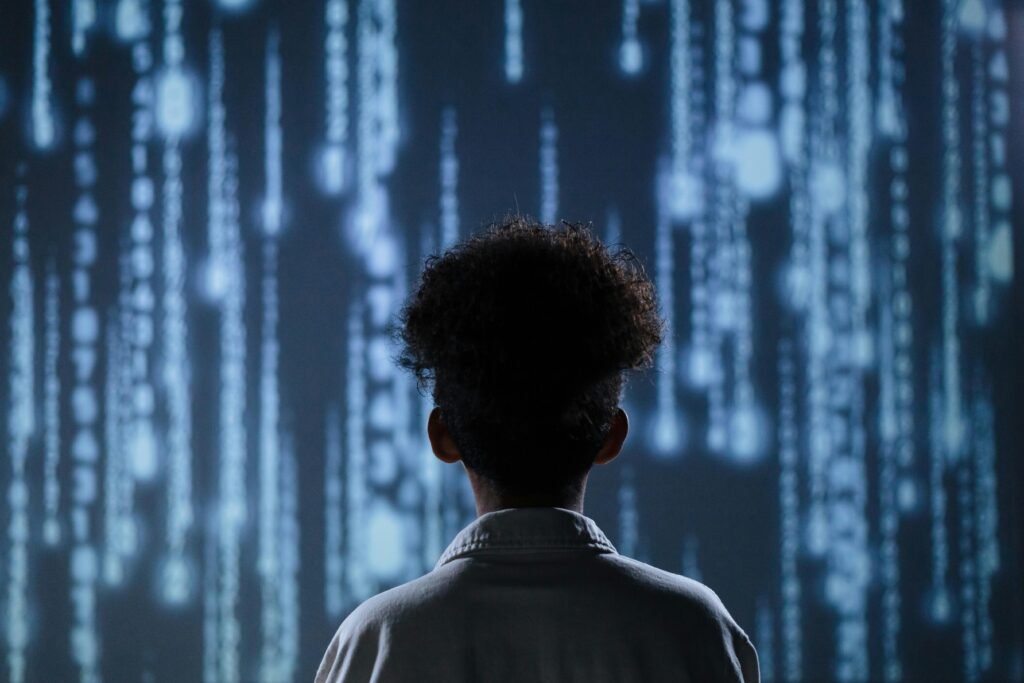👶 AI Risk for Kids: What Every Parent Needs to Know in 2025

Artificial intelligence (AI) is shaping the future of how children learn, play, and interact with technology. From smart toys to personalized learning apps, AI can make childhood more exciting—but it also brings new risks for kids that parents can’t afford to ignore.
This article explores the real AI risks for kids, how to manage them, and how to help children use AI safely and responsibly.

💡 What Is AI for Kids?
AI for kids includes any technology that uses artificial intelligence to interact, teach, or entertain children. Examples include:
- Educational apps that adapt to a child’s learning pace
- Chatbots that talk like humans
- Smart toys that “learn” from children’s behavior
- Virtual assistants like Alexa or Google Assistant
These tools can make learning fun—but they also collect data, shape opinions, and influence emotions. That’s where the AI risk for kids begins.
⚠️ Major AI Risks for Kids in 2025
Let’s look at the top risks experts are warning about this year.
1. Privacy and Data Collection
AI systems often collect personal information from children—such as voice recordings, location, or learning habits.
If not properly protected, this data could be misused or leaked, putting a child’s privacy at risk.
2. Exposure to Inappropriate Content
Some AI chatbots or content-generation tools can accidentally produce harmful or age-inappropriate content, even when designed for children.
3. Emotional Manipulation
AI-powered games and virtual assistants can influence how kids think or feel by rewarding certain behaviors or responses, leading to subtle manipulation.
4. Bias and Stereotyping
AI systems learn from existing data, which may contain gender, racial, or cultural biases—and these can be passed on to young users.
5. Reduced Human Interaction
As children spend more time with AI devices, they might interact less with real people, affecting social and emotional development.
🧠 The Positive Side: AI Can Still Be Good for Kids
Despite the risks, AI isn’t the enemy. When used wisely, it can be an incredible learning tool.
For example:
- AI tutors can help kids learn math, reading, or languages at their own pace.
- AI translation tools make it easier for multilingual families to communicate.
- Educational robots can make STEM learning fun and engaging.
The key is balance and supervision—AI should support, not replace, human learning and interaction.
🛡️ How Parents Can Reduce AI Risks for Kids
Here’s what parents and educators can do to protect children:
- Review App Permissions – Always check what data apps or devices collect.
- Use Child-Safe AI Platforms – Choose apps with verified parental controls and privacy certifications.
- Educate Kids About AI – Explain that AI is not “real” thinking—it’s software that predicts and responds.
- Limit Screen Time – Encourage real-world play and family interaction.
- Stay Updated – Keep track of new AI trends and government regulations for child safety.
🌍 What Governments Are Doing
In 2025, many regions are taking AI risks for kids seriously:
- The U.S. is updating child privacy laws like COPPA to include AI applications.
- The European Union is enforcing the AI Act, requiring stronger safeguards for minors.
- Canada and Australia are working on ethical AI frameworks focusing on transparency and safety in educational tech.
These steps are vital—but parents still play the biggest role in protecting kids.
❤️ Final Thoughts: AI Should Empower, Not Exploit
AI isn’t going away—it’s becoming part of childhood.
The goal isn’t to ban it, but to teach children to use AI responsibly and ensure that companies handle data and design ethically.
If parents stay informed and involved, AI can become a positive force for learning, creativity, and curiosity—without exposing kids to unnecessary risks.
❓FAQs About AI Risk for Kids
1. What is the biggest AI risk for kids?
The biggest risk is data privacy, as many AI tools collect sensitive information from children that could be misused if not properly protected.
2. Are AI toys safe for children?
AI toys can be safe if they meet privacy standards and don’t collect unnecessary data. Always check reviews and manufacturer policies before purchase.
3. Can AI affect my child’s behavior?
Yes, prolonged interaction with AI systems can subtly influence behavior, especially through emotional responses or reward-based games.
4. How can I teach my child to use AI safely?
Start by explaining how AI works, set screen-time limits, and guide them to use trusted, age-appropriate platforms.
5. Will schools use AI more in the future?
Absolutely. Many schools already use AI for personalized learning, but governments are setting stricter rules to ensure it’s used safely.





